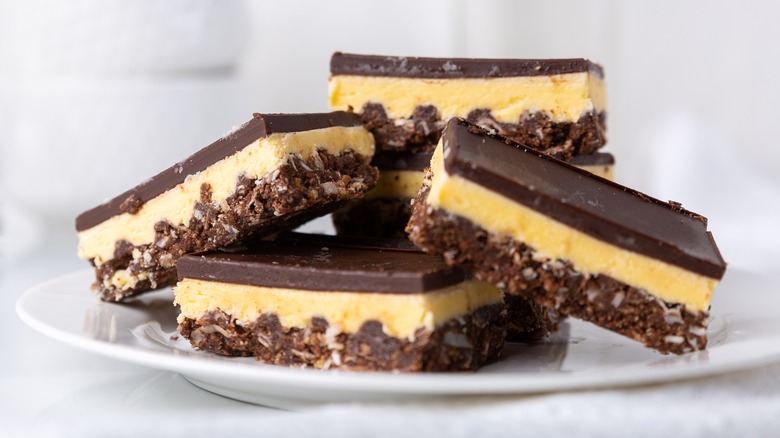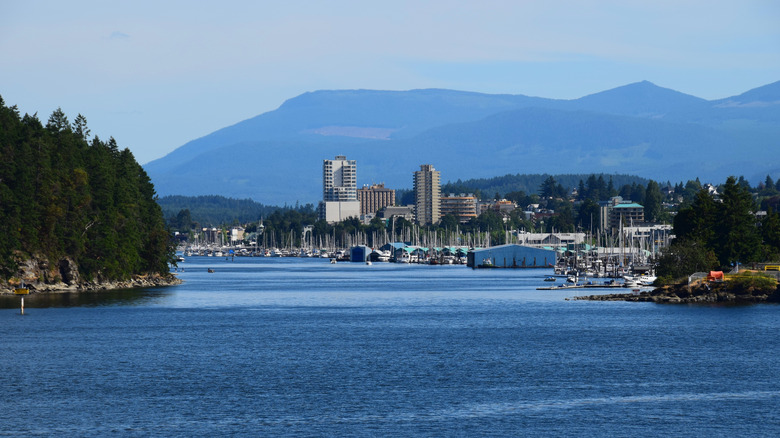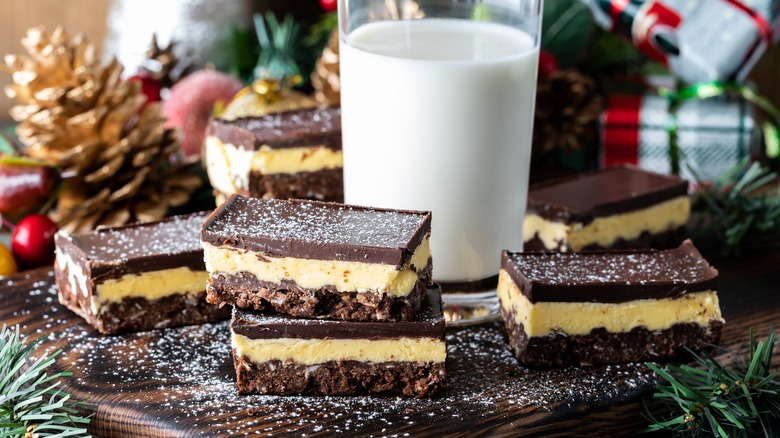Nanaimo Bars Are Canada's Most Iconic No-Bake Dessert
How does one define Canadian cuisine? As noted by Encyclopedia Britannica, Canada's culture is sometimes dismissed as being basically the same as American culture with some British and French influences, too. However, there's a lot more to it than that. The indigenous peoples of Canada, for example, have had an enormous influence on the customs of the country. Plus, evermore immigrants from various backgrounds are joining the nation, bringing their own practices with them. All of this melds together to form a unique, multifaceted social identity.
How does this manifest in Canadian diets? As former Prime Minister Joe Clark once said, the nation's cuisine is a smorgasbord (via Canadian Food Focus). In addition to American, English, French, and Indigenous influences, elements of Chinese, Indian, Jamaican, Polish, Russian, Sri Lankan, Ukrainian, and Vietnamese culture (to name just a few) can be found in the foods and drinks of Canada. More specifically, edible items like butter tarts, maple syrup, poutine (cheese-and-gravy fries), Saskatoon berries, and tourtières (meat pies) represent this country proudly.
Then, there's the Nanaimo bar!
Nanaimo is a city and a dessert
More than a no-bake dessert, Nanaimo is also a city, located on Vancouver Island in the Georgia Strait of British Columbia, Canada, per Britannica. It was first founded under a different name (it's had several) to take advantage of the local coalfields. Eventually, it became a prominent port city, and nowadays, agriculture, fishing, lumbering, shipbuilding, and tourism are among its economic activities. While annual bathtub races bring visitors in yearly, one of its biggest draws is the no-bake dessert that takes its name from this place.
The City of Nanaimo lists graham crumbs, cocoa and coconut, sugar and butter, custard filling, and a layer of chocolate as the five base ingredients for its iconic treat. Luckily, for those who can't stand the heat, you won't have to get out of the kitchen when making Nanaimo bars, because there's no baking involved. The process consists mostly of stirring, pressing, spreading, and pouring, with just a little bit of melting, too. The result is so beloved, it's even been commemorated on an official Canadian stamp. Plus, there's the so-called Nanaimo Bar Trail in its namesake city, where sightseers can try classic Nanaimos, as well as specialties like cheesecake, cotton candy, cupcake, gluten-free, fudge, ice cream, macaron, organic, raw, spring roll, and vegan variations in the area. There are also cocktail, coffee, and tea forms of the bars available, plus inedible recreations for display. Clearly, the Nanaimo bar is a Canadian food worth traveling for.
The invention of Nanaimo bars
At face value, it's pretty obvious where Nanaimo bars came from: Nanaimo city. There's a bit more to the story, though. As Nuvo Magazine notes, anecdotal evidence suggests the recipe has been around as an award-winning treat since the 1930s, just under different names. For instance, it's also been called a London fog bar and a New York slice, according to British Columbia Magazine.
The first written proof of the Nanaimo bar comes from 1952 in the Women's Auxiliary of the Nanaimo Hospital Cookbook, where it's referred to as a "chocolate square" (via Montecristo Magazine). One year later, a slight variation on the recipe appeared as a "Nanaimo bar" in Edith Adams' Cookbook. By 1986, the dessert was well known, and a contest was put on to find the best recipe. That same year, the Nanaimo bar's mascot, Nanaimo Barney, was unveiled, and the bars began to be professionally made and sold. Nowadays, the bar can be found not only across Canada, but also in Asia and Europe. What began as a mid-1900s cocktail party finger food has since become a national celebrity.
At the end of the day, practically no one knows when, where, and how the first Nanaimo bar came about. The City of Nanaimo requests that anybody with written evidence of the dessert dating back to the '50s or earlier let them know. Now that you know all about Canada's most iconic no-bake dessert, maybe you can aid in the search!


